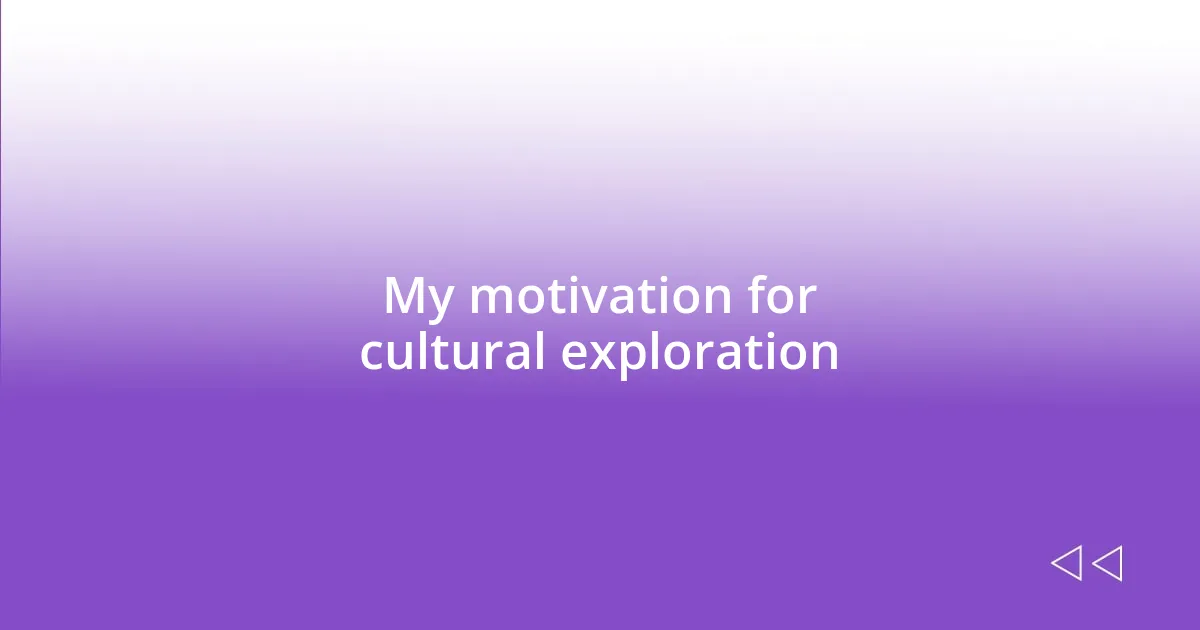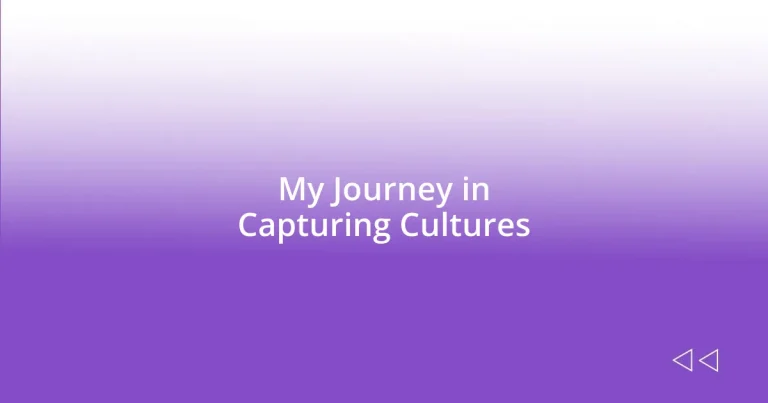Key takeaways:
- Exploration of different cultures enhances personal growth and understanding, as shown through experiences in Japan and Italy.
- Immersive photography techniques include storytelling, engaging with locals, and utilizing ambient light to deepen cultural narrative.
- Building connections with local communities involves sharing meals, active listening, and participating in cultural festivities for genuine engagement.
- Sharing cultural experiences online can foster understanding by highlighting authentic moments and engaging storytelling that resonates with a diverse audience.

My motivation for cultural exploration
My motivation for cultural exploration often stems from a deep curiosity about what makes each culture unique. I remember my first trip to Japan; every moment was a revelation. I found myself fascinated by how traditions, like the tea ceremony, encapsulated values of respect, harmony, and tranquility. Isn’t it incredible how a simple act can carry such profound meaning?
I’ve often considered how exploration shapes our perspective and personal growth. During a visit to a small village in Italy, I shared dinner with a local family. Their stories, rich with history and resilience, reminded me that every place has its owns struggles and triumphs. How often do we overlook the stories that shape our everyday experiences?
Being immersed in different cultures fuels my passion for connection and understanding. I recall standing in the bustling markets of Marrakech, surrounded by vibrant colors and aromas. It hit me then—how different yet similar we all are in our quest for joy and belonging. Doesn’t this shared humanity inspire you to explore beyond your comfort zone?

Techniques for immersive photography
Capturing the essence of a culture requires the right techniques in immersive photography. One technique I often use is storytelling through images. For instance, during a recent trip to India, I focused on the rich tapestry of daily life. I framed my shots to include not just the vibrant colors of saris but also the busy streets and the serene moments of prayer at temples. This approach brings depth to the photos, allowing the viewer to feel the pulse of the culture rather than just see it.
Another technique I recommend is engaging with locals. When I was in Peru, I spent time with artisans in a small village, learning about their craft. This experience transformed my photography; each click of the shutter was a moment of shared passion and tradition. The photos I took felt alive, infused with the spirit of the artisans. Their stories added layers of meaning to the images, creating a connection that resonates with anyone who views them.
Finally, the use of ambient light is crucial in immersive photography. I noticed this while wandering through Lisbon at dusk. The golden hour cast a warm glow on the cobblestone streets, highlighting the contrasts of architectural styles that tell the story of the city. By paying attention to natural light, I was able to create a mood that reflected the soul of the culture and the memories I made there.
| Technique | Description |
|---|---|
| Storytelling | Focusing on images that convey narratives, such as daily life and traditions. |
| Engagement with Locals | Connecting with people to capture authentic moments and insights. |
| Use of Ambient Light | Utilizing natural light to enhance the mood and depth of photographs. |

Understanding cultural nuances and contexts
Understanding different cultural nuances and contexts is essential for meaningful engagement. I remember standing on a busy street in Istanbul, enchanted by the blend of ancient traditions and modern life. I noticed how people interacted—the respectful nods exchanged between shopkeepers and customers revealed a cultural expectation of warmth and connection. These small details made me realize that recognizing subtle social cues can open doors to deeper interactions.
- Body language can vary dramatically; for instance, while a firm handshake is a sign of confidence in many cultures, it might be perceived as too aggressive in others.
- Local customs, such as gift-giving protocols, reveal what is valued within a culture—be it hospitality, respect, or status.
- Understanding humor is equally vital; what might be hilarious in one culture could be completely misunderstood in another, leading to uncomfortable situations.
Therefore, embracing the intricacies of a culture not only enriches our experiences but also fosters genuine relationships that transcend borders.

Building connections with local communities
Building connections with local communities often means stepping out of your comfort zone and embracing vulnerability. I recall my time in a small fishing village in Indonesia, where I was invited to share a meal with a family. As we sat around the table, the laughter and stories flowed freely. It struck me how food can serve as a universal bridge, creating an intimate space for connection. Have you ever experienced a moment where sharing a dish drew you closer to someone? It’s those shared experiences that illuminate the beauty of cultural exchange.
Another important aspect of connecting with locals is active listening. When I was in a Maasai village in Kenya, I engaged in conversations with the community members about their traditions and daily lives. I learned the value of pausing and genuinely absorbing their stories, rather than just waiting for my turn to speak. This simple act fostered trust and allowed me to capture their essence in my photography. It’s amazing how listening can invite others to reveal their authentic selves, don’t you think?
Moreover, participating in local festivals can significantly strengthen these connections. I vividly remember joining a vibrant Holi celebration in India, where colors exploded in the air, and emotions ran high. Dancing, laughing, and playing with strangers who quickly became friends created a sense of belonging. Experiencing the joy and chaos of a local festivity not only provides unforgettable memories but also celebrates the unique spirit of a community. How could anyone walk away from such an experience unchanged?

Tips for storytelling through images
To tell a compelling story through images, focus on capturing emotions that resonate with viewers. I remember photographing a grandmother in a rural village; her weathered face told a lifetime of joys and sorrows. Instead of just showing her surrounded by her grandkids, I zoomed in on her hands—wrinkled and calloused—cradling a handmade rug. This perspective invites the audience to connect with her story on a deeper level. Have you considered how a single focused detail can evoke such powerful feelings?
Lighting plays a crucial role in storytelling. I once shot a sunset over a bustling market in Marrakech, and the golden hues transformed the ordinary into something magical. The soft glow illuminated faces and enhanced the vibrant colors of spices and textiles. Intentionally using natural light can dramatically shift the mood of your images and amplify the story you want to share. Don’t you agree that the right light can almost breathe life into a photograph?
Lastly, incorporating movement in your shots adds dynamism and urgency to your narratives. During a traditional dance ceremony in Bali, I snapped images of performers mid-leap, their expressions reflecting passion and dedication. Capturing those fleeting moments makes the viewer feel like they are part of the action, drawing them into the experience. How often have you looked at an image and felt as though you were right there in the moment? That’s the power of storytelling through images.

Sharing your cultural experiences online
Sharing cultural experiences online can be a profound way to foster understanding and connection across diverse backgrounds. I remember posting about a lively dance lesson I took in a small town in Peru. As I shared the video, the comments poured in—not just from friends, but from people around the world who connected with the joy and missteps of my journey. It was heartwarming to see how a simple dance could resonate so widely, sparking conversations about our respective cultures and traditions. Have you ever considered how your own stories can create a ripple effect online?
Moreover, engaging with your audience through storytelling enhances the impact of your shared experiences. I once wrote a blog post about an evening spent participating in a community art project in Mexico, where locals transformed a dull wall into a vibrant mural. By detailing the emotions I felt during that creative process and the friendships I forged, I noticed the engagement skyrocketed. Readers appreciated not just the visual elements but also the narrative that brought them into the heart of the experience. Isn’t it fascinating how words can transport people to places they’ve never been?
When curating content for social media, focusing on authenticity is vital. I learned this firsthand during my travels in Ghana, where I posted candid shots of street vendors and bustling markets. These images captured raw moments, from a younger child’s laughter to an elderly vendor’s wisdom. Followers responded positively because they felt they were experiencing the culture through my lens. It’s incredible how sharing authentic moments can break down barriers and encourage others to reflect on their own cultural journeys, wouldn’t you agree?












